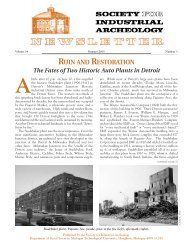birmingham, “pittsburgh of the south,” - Society for Industrial ...
birmingham, “pittsburgh of the south,” - Society for Industrial ...
birmingham, “pittsburgh of the south,” - Society for Industrial ...
Create successful ePaper yourself
Turn your PDF publications into a flip-book with our unique Google optimized e-Paper software.
The Smallest Oil Refinery in <strong>the</strong> U.S.<br />
Zahir Khalid, businessman and <strong>for</strong>mer Pakistani air<strong>for</strong>ce fighter pilot, reports on<br />
<strong>the</strong> odd set <strong>of</strong> circumstances that led to his ef<strong>for</strong>ts to preserve <strong>the</strong> 1933 C & H<br />
Oil Refinery in Lusk, Wyoming, which may be <strong>the</strong> smallest in <strong>the</strong> world.<br />
In October 1998, while surfing <strong>the</strong> Internet at my home in<br />
Islamabad, Pakistan, I came across a sale advertisement <strong>for</strong><br />
an oil refinery in Wyoming. Just <strong>for</strong> <strong>the</strong> sake <strong>of</strong> curiosity, I<br />
dialed <strong>the</strong> telephone number and I was connected with a<br />
gentleman in Louisiana who faxed me some limited in<strong>for</strong>mation<br />
about <strong>the</strong> refinery. One thing led to ano<strong>the</strong>r and I found<br />
myself talking to <strong>the</strong> owner, Joe Chamberlain. What attracted me<br />
most to <strong>the</strong> refinery were his words defining it as “<strong>the</strong> smallest oil<br />
refinery in <strong>the</strong> United States<strong>”</strong> with a production capacity <strong>of</strong> only<br />
190 barrels per day. I started to imagine it to be <strong>the</strong> cutest <strong>of</strong><br />
refineries. I researched, contacted people, and read whatever I<br />
could lay my hands on about <strong>the</strong> subject. No one seemed to<br />
believe that <strong>the</strong>re existed a refinery with such a tiny production<br />
capacity because modern-day refineries have a capacity in excess<br />
<strong>of</strong> over 250,000 barrels per day. I decided to visit <strong>the</strong> United<br />
States in order to see it <strong>for</strong> myself.<br />
In November, Chamberlain picked me up from <strong>the</strong> Denver airport.<br />
The next morning we set course <strong>for</strong> Wyoming to see <strong>the</strong><br />
refinery, closed 20 years earlier. To my Pakistani sensibilities, it<br />
was overwhelming to see <strong>the</strong> vast open and empty land as we<br />
drove toward Lusk. We finally reached <strong>the</strong> town with a population<br />
<strong>of</strong> barely 1,500 people. As we came to a stop in front <strong>of</strong> a<br />
bunch <strong>of</strong> trees and a rudimentary structure <strong>of</strong> some sort, covered<br />
with grass and shrubs, <strong>the</strong> owner pointed toward this location and<br />
identified it as <strong>the</strong> refinery that I had been so eager to see.<br />
Shocked by <strong>the</strong> state <strong>of</strong> <strong>the</strong> outfit in front <strong>of</strong> me, I felt <strong>the</strong> life<br />
draining out <strong>of</strong> my legs.<br />
I inspected <strong>the</strong> location. I could see only oil tanks outside a small<br />
building <strong>of</strong> 28 ft. ✕ 50 ft. <strong>of</strong> sheet iron. There were holes in <strong>the</strong><br />
walls and ro<strong>of</strong>. A 2 ft.-wide door allowed us entry to <strong>the</strong> building.<br />
It was a discouraging sight, vines creeping all over <strong>the</strong> floors and<br />
walls, which were giving way with mud oozing out <strong>of</strong> <strong>the</strong>m. As I<br />
decided to give it up as bad joke, <strong>the</strong> owner pointed at two metal<br />
doors and said, “<strong>the</strong> Smithsonian wanted <strong>the</strong>se stills from me 20<br />
years ago.<strong>”</strong> These words shook me up. The smallest refinery in <strong>the</strong><br />
C&H Oil Refinery from a ca. 1950 advertisement.<br />
<strong>Society</strong> <strong>for</strong> <strong>Industrial</strong> Archeology Newsletter, Vol.28, No. 4, Winter 1999<br />
nation, built in 1933,<br />
an institution like <strong>the</strong><br />
Smithsonian interested<br />
in <strong>the</strong> stills—perhaps<br />
<strong>the</strong>re was something<br />
valuable here.<br />
Anyone could see<br />
that <strong>the</strong> refinery was a<br />
commercial disaster,<br />
but here was a challenge<br />
to bring it back<br />
to an operational state<br />
and preserve it as a<br />
piece <strong>of</strong> American<br />
heritage. I decided to<br />
buy <strong>the</strong> place. The<br />
owner demanded<br />
immediate cash, probably<br />
because he did<br />
not believe that I was<br />
serious. It took me a<br />
day to arrange <strong>the</strong><br />
Owner Zahir Khalid stands beside one <strong>of</strong><br />
<strong>the</strong> late-19th-century Erie City Iron Work<br />
stills at <strong>the</strong> Lusk, Wyoming refinery.<br />
required amount and I became <strong>the</strong> owner <strong>of</strong> <strong>the</strong> C&H Refinery. My<br />
objective was to return <strong>the</strong> refinery to running condition.<br />
The building is insulated by primitive methods; <strong>the</strong> walls are<br />
made <strong>of</strong> two metal sheets with mud filled in between <strong>the</strong>m. Inside<br />
this tiny room are two stills manufactured by <strong>the</strong> Erie City (PA)<br />
Iron Works. Apparently, <strong>the</strong> stills were fabricated in <strong>the</strong> late-19th<br />
century and moved to Lusk in 1933. There are three steam-driven<br />
pumps and a boiler. All <strong>the</strong>se things are connected with numerous<br />
pipe lines, which seem to run everywhere in <strong>the</strong> room. On<br />
<strong>the</strong>se pipes <strong>the</strong>re are many valves and pressure and temperature<br />
gauges. The firing <strong>of</strong> <strong>the</strong> stills is an event in itself. Even in <strong>the</strong>se<br />
modern times <strong>the</strong>y are ignited with a burning piece <strong>of</strong> cloth tied<br />
to <strong>the</strong> end <strong>of</strong> a long rod. The levels <strong>of</strong> crude inside are measured<br />
using an old reliable method: glass tubes. Ventilators are opened<br />
and closed by pulling ropes.<br />
I could not possibly have predicted <strong>the</strong> difficulties involved in<br />
bringing back to life an oil refinery that had been so long dormant.<br />
There were no written guides or instructions. There was no help<br />
<strong>for</strong>thcoming, as anyone known to have been closely associated with<br />
<strong>the</strong> refinery’s operation was no longer living. Helplessness was a<br />
good way to describe my feelings. My living 12,000 miles away from<br />
<strong>the</strong> site fur<strong>the</strong>r complicated things. But as it is said, “when <strong>the</strong>re is<br />
a will <strong>the</strong>re is a way.<strong>”</strong> I assembled a team <strong>of</strong> local helpers, and so<br />
through trial-and-error method we started inching <strong>for</strong>ward.<br />
While no specific task was without problems, <strong>the</strong> most trying,<br />
complicated, and hazardous was cleaning <strong>the</strong> stills. They are tanklike<br />
structures when viewed from <strong>the</strong> outside. Inside <strong>the</strong>y contain<br />
a hollow space and a honeycomb <strong>of</strong> pipes evenly spaced. There<br />
are <strong>of</strong> course inlets and outlets. The hollow space is filled with<br />
crude oil and steam passes through <strong>the</strong> pipes, eventually boiling<br />
<strong>the</strong> crude and taking it through various temperature levels to col-<br />
(continued on page 14)<br />
13<br />
Richard L. Collier, Wyoming State Historic Preservation Office, photo






